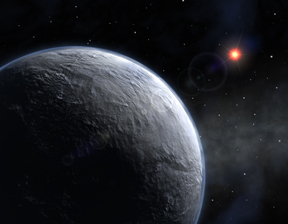 A newly discovered
planet may be the most Earth-like planet found to date outside our solar system.
The discovery confirms the value of a relatively new detection method known
as gravitational lensing, astronomers say.
A newly discovered
planet may be the most Earth-like planet found to date outside our solar system.
The discovery confirms the value of a relatively new detection method known
as gravitational lensing, astronomers say.A team of astronomers used a star as a kind of lens to magnify an almost-Earth-sized planet orbiting a star 20,000 light years away, shown here in this artist’s conception. Image is courtesy of National Science Foundation.
More than 20,000 light years away from Earth, the planet orbits a star at a distance three times that between Earth and the sun, likely putting temperatures on the planet at negative 220 degrees Celsius. The planet is also five times the size of Earth, just at the border between a small rocky planet and a large gaseous, Jupiter-like planet, which has led researchers to speculate that the body is a mix of the two. Publishing the findings in the Jan. 26 Nature, the 73 authors from more than 30 institutions say that the new detection method will help forward the discovery of additional, perhaps more hospitable Earth-like planets closer to their parent stars.
The detection method relies on another star that sits on the viewing path between Earth and the faraway dwarf star: The intermediary star’s gravity pulls the light that is traveling toward Earth from both the planet and its home star, allowing astronomers to capture images of the planet as it passes in front of its star. The middle star acts like a lens, as described by Alan Boss of the Carnegie Institution of Washington, chair of the International Astronomical Union working group that keeps the official list of extrasolar planets. This discovery looks legitimate and confirms the gravitational lensing method, which is several years old, Boss said at a Geological Society of Washington meeting on Jan. 25, the day the finding was announced. The composition of the planet is still unknown, despite speculation that it may be a small rocky body with an outer gas layer similar to that of a Jupiter-like planet. That uncertainty, says Boss, who is not affiliated with the team, might inspire new models of planetary formation to explain that mix.

